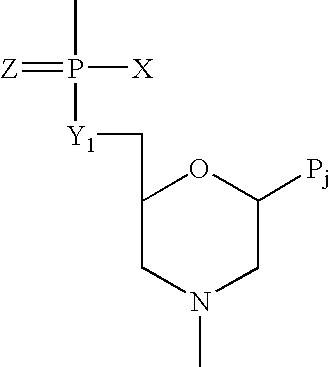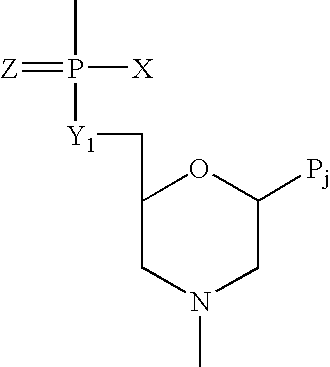Antisense antiviral compounds and methods for treating foot and mouth disease
- Summary
- Abstract
- Description
- Claims
- Application Information
AI Technical Summary
Benefits of technology
Problems solved by technology
Method used
Image
Examples
example 1
Inhibition of FMDV Replication in Tissue Culture
[0143] The antiviral activity of FMDV-specific PMOs was determined by the virus titer reduction on infected BHK-21 cells. The test is performed on BHK-21 cell monolayers (12-well plates) with the pretreatment of each cell monolayer with a particular PMO generally from 1 to 5 uM. Following three hours of treatment with the antiviral compound, the media is removed and the virus is added to the cells and the incubation proceeds for 1 h at 37° C. Following adsorption, the unbound virus is removed and the media is replaced by fresh PMO at the same concentration used during pretreatment, and the infection is allowed to proceed for 24 h at 37° C. Virus yield is determined by plaque assay following three freeze-thaw cycles of infected / treated BHK-21 cells. Cytotoxicity is typically evaluated by determining live cells under increasing drug concentration using an assay well known in the art (MTT Assay). A window of drug concentrations was selec...
PUM
| Property | Measurement | Unit |
|---|---|---|
| Temperature | aaaaa | aaaaa |
| Molar density | aaaaa | aaaaa |
| Antimicrobial properties | aaaaa | aaaaa |
Abstract
Description
Claims
Application Information
 Login to View More
Login to View More - R&D
- Intellectual Property
- Life Sciences
- Materials
- Tech Scout
- Unparalleled Data Quality
- Higher Quality Content
- 60% Fewer Hallucinations
Browse by: Latest US Patents, China's latest patents, Technical Efficacy Thesaurus, Application Domain, Technology Topic, Popular Technical Reports.
© 2025 PatSnap. All rights reserved.Legal|Privacy policy|Modern Slavery Act Transparency Statement|Sitemap|About US| Contact US: help@patsnap.com



